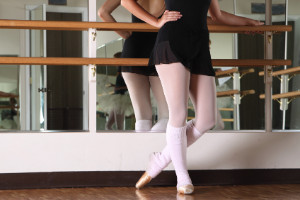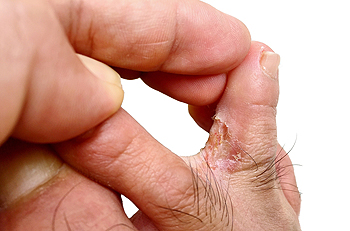 Research has indicated many ballet dancers are afflicted with ingrown toenails. This is often the result of balancing on top of the toes, which can cause the corner of the nail to grow into the surrounding skin. An ingrown toenail typically causes pain and discomfort and may become infected if it is not treated promptly. Many ballet dancers may notice soreness while putting on ballet slippers and pointing the toes can cause extreme pain. Some of the symptoms associated with ingrown toenails can include swelling around the nail, or you may notice a discharge draining from the nail. Mild relief can be found when the toe is soaked in warm water and is helpful in softening the skin around the affected area. If you feel you have an ingrown toenail, consult with a podiatrist so proper treatment can begin.
Research has indicated many ballet dancers are afflicted with ingrown toenails. This is often the result of balancing on top of the toes, which can cause the corner of the nail to grow into the surrounding skin. An ingrown toenail typically causes pain and discomfort and may become infected if it is not treated promptly. Many ballet dancers may notice soreness while putting on ballet slippers and pointing the toes can cause extreme pain. Some of the symptoms associated with ingrown toenails can include swelling around the nail, or you may notice a discharge draining from the nail. Mild relief can be found when the toe is soaked in warm water and is helpful in softening the skin around the affected area. If you feel you have an ingrown toenail, consult with a podiatrist so proper treatment can begin.
Ingrown toenails can become painful if they are not treated properly. For more information about ingrown toenails, contact Dr. Tina Oliver of Astro Foot Care, PA. Our doctor can provide the care you need to keep you pain-free and on your feet.
Ingrown Toenails
Ingrown toenails occur when a toenail grows sideways into the bed of the nail, causing pain, swelling, and possibly infection.
Causes
Prevention
Because ingrown toenails are not something found outside of shoe-wearing cultures, going barefoot as often as possible will decrease the likeliness of developing ingrown toenails. Wearing proper fitting shoes and using proper cutting techniques will also help decrease your risk of developing ingrown toenails.
Treatment
Ingrown toenails are a very treatable foot condition. In minor cases, soaking the affected area in salt or antibacterial soaps will not only help with the ingrown nail itself, but also help prevent any infections from occurring. In more severe cases, surgery is an option. In either case, speaking to your podiatrist about this condition will help you get a better understanding of specific treatment options that are right for you.
If you have any questions please feel free to contact our office located in Houston, TX. We offer the newest diagnostic and treatment technologies for all your foot and ankle needs.
Read more about Ingrown Toenail Care The location of a plantar wart is on the sole of the foot. It often develops in the heel area of the foot and grows into the skin. This is a result of consistent weight that is put on the heel while walking or standing. The fungus that causes this type of wart is known as the human papillomavirus (HPV) and is considered to be contagious. Some of the symptoms that are associated with this condition include a hard and callused area on the heel of the foot, and pain while bearing weight on the foot. Additionally, clotted blood vessels will often appear in the center, which look like tiny black dots. This type of fungus thrives in warm and moist places, which include public swimming pools and surrounding areas, and can easily spread by sharing socks or towels. If you would like information about proper treatment options for a plantar’s wart, please counsel with a podiatrist.
The location of a plantar wart is on the sole of the foot. It often develops in the heel area of the foot and grows into the skin. This is a result of consistent weight that is put on the heel while walking or standing. The fungus that causes this type of wart is known as the human papillomavirus (HPV) and is considered to be contagious. Some of the symptoms that are associated with this condition include a hard and callused area on the heel of the foot, and pain while bearing weight on the foot. Additionally, clotted blood vessels will often appear in the center, which look like tiny black dots. This type of fungus thrives in warm and moist places, which include public swimming pools and surrounding areas, and can easily spread by sharing socks or towels. If you would like information about proper treatment options for a plantar’s wart, please counsel with a podiatrist.
Plantar warts can be very uncomfortable. If you need your feet checked, contact Dr. Tina Oliver from Astro Foot Care, PA. Our doctor will assist you with all of your foot and ankle needs.
About Plantar Warts
Plantar warts are the result of HPV, or human papillomavirus, getting into open wounds on the feet. They are mostly found on the heels or balls of the feet.
While plantar warts are generally harmless, those experiencing excessive pain or those suffering from diabetes or a compromised immune system require immediate medical care. Plantar warts are easily diagnosed, usually through scraping off a bit of rough skin or by getting a biopsy.
Symptoms
Treatment
To help prevent developing plantar warts, avoid walking barefoot over abrasive surfaces that can cause cuts or wounds for HPV to get into. Avoiding direct contact with other warts, as well as not picking or rubbing existing warts, can help prevent the further spread of plantar warts. However, if you think you have developed plantar warts, speak to your podiatrist. He or she can diagnose the warts on your feet and recommend the appropriate treatment options.
If you have any questions please feel free to contact our office located in Houston, TX. We offer the newest diagnostic and treatment technologies for all your foot and ankle needs.
Read more about All About Plantar WartsWhen walking first begins, many children walk with their feet apart, and this is beneficial in maintaining balance. The gap between the feet will gradually close as the walking process is perfected. Additional common foot conditions include flat feet, or you may notice your three year old is walking on tiptoes. Research has indicated the importance of walking barefoot while indoors, and this helps to strengthen the muscles in the feet. When the first shoes are purchased, it is helpful to choose shoes that have laces or buckles. This helps the foot to fit securely in the shoe. Additionally, the toenails must be trimmed correctly, and this is necessary in possibly preventing ingrown toenails from occurring. If you have any questions about the development of your child’s feet, it is suggested to speak to a podiatrist who can properly assist you.
The health of a child’s feet is vital to their overall well-being. If you have any questions regarding foot health, contact Dr. Tina Oliver of Astro Foot Care, PA. Our doctor can provide the care you need to keep you pain-free and on your feet.
Tips for Keeping Children's Feet Healthy
If you have any questions, please feel free to contact our office located in Houston, TX. We offer the newest diagnostic and treatment technologies for all your foot care needs.
Read more about How to Care for Your Child's Feet Corns on the feet can be quite painful. They are hard areas of skin, and can develop between the toes, or on the bottom or sides of the feet. Typical symptoms often include pain while wearing shoes, rough or bumpy skin around the affected area, and it may be tender if touched. This foot condition develops as a result of wearing shoes that do not fit correctly, which may cause friction between the toes and the shoe. Mild relief is obtained when the foot is soaked in warm water, and this helps to soften the corn. Wearing a corn pad may lessen the pain, and this may aid in the healing process. If the pain from the corn prevents you from completing daily activities, it is advised that you schedule a consultation with a podiatrist who can implement methods for removal of the corn.
Corns on the feet can be quite painful. They are hard areas of skin, and can develop between the toes, or on the bottom or sides of the feet. Typical symptoms often include pain while wearing shoes, rough or bumpy skin around the affected area, and it may be tender if touched. This foot condition develops as a result of wearing shoes that do not fit correctly, which may cause friction between the toes and the shoe. Mild relief is obtained when the foot is soaked in warm water, and this helps to soften the corn. Wearing a corn pad may lessen the pain, and this may aid in the healing process. If the pain from the corn prevents you from completing daily activities, it is advised that you schedule a consultation with a podiatrist who can implement methods for removal of the corn.
Corns can make walking very painful and should be treated immediately. If you have questions regarding your feet and ankles, contact Dr. Tina Oliver of Astro Foot Care, PA. Our doctor will treat your foot and ankle needs.
Corns: What Are They? And How Do You Get Rid of Them?
Corns are thickened areas on the skin that can become painful. They are caused by excessive pressure and friction on the skin. Corns press into the deeper layers of the skin and are usually round in shape.
Ways to Prevent Corns
There are many ways to get rid of painful corns such as:
Treating Corns
Although most corns slowly disappear when the friction or pressure stops, this isn’t always the case. Consult with your podiatrist to determine the best treatment option for your case of corns.
If you have any questions please feel free to contact our office located in Houston, TX. We offer the newest diagnostic and treatment technologies for all your foot and ankle needs.
Read more about Understanding Corns and Calluses